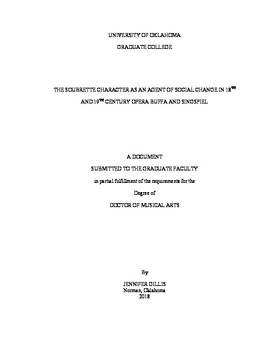| dc.description.abstract | The secondary female role of lower class status in comic opera, designated by the term soubrette, is often given a diminutive value to match her diminutive name ending. As a result, the origins of the soubrette figure and how the role developed and changed throughout the history of comic opera have not been studied in detail. While Italian soubrette characters from eighteenth century opera buffa productions have been recognized, little attention has been paid to the soubrette characters of German Singspiel despite their strong representation. Scholars have assumed that this archetypal role is superficial and insignificant to the plot, but nothing could be further from the truth. In most plot scenarios, the soubrette character contributes to the plot complications and resolutions more than the primary heroine. Because the soubrette role stems from the action-based medium of the Commedia dell’Arte tradition, the character thrives through action while the primary heroine wallows in introspection. Soubrette roles are often described as having music that contributes a superficial image, such as shorter phrases, smaller ranges, and bubbling rhythms. However, these traits coincide with the active musical topics, or topoi, that are associated with the activities of peasant life, such as peasant dances.
This document will trace the origins of the soubrette role in opera buffa to the stock character Colombina as depicted by Caterina Biancolelli, an actress who performed with the seventeenth century Gelosi Commedia dell’Arte troupe. The purpose will be to define the archetypal characteristic and musical qualities of the soubrette of opera buffa and German Singspiel in order to advocate for the soubrette’s value as a key figure for understanding the social climate of the eighteenth and nineteenth centuries. This document will pursue a hermeneutic approach of particular soubrette repertoire by interpreting the use of specific musical topics by composers, which define, question or deny the social stratification and gender relations of the soubrette. | en_US |
